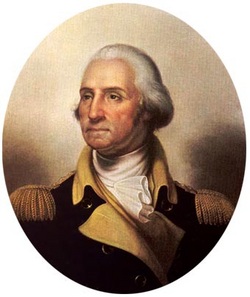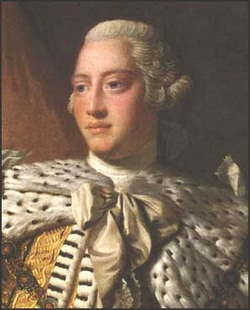George Washington

George Washington
We all know who this fellow is, but, of course, he needs to be mentioned for his duties as commander and chief of the Continental Army. He mainly reported to the Second Continental Congress. Washington had three roles during the war. In 1775-77, and again in 1781 he led his men against the main British forces. Although he lost many of his battles, he never surrendered his army during the war, and he continued to fight the British relentlessly until the war's end. He plotted the overall strategy of the war, in cooperation with Congress.
Second, he was charged with organizing and training the army. He recruited regulars and assigned General von Steuben, a German professional, to train them. He was not in charge of supplies, which were always short, but kept pressuring Congress and the states to provide essentials. Washington had the major voice in selecting generals for command, and in planning their basic strategy. His achievements were mixed, as some of his favorites (like John Sullivan) never mastered the art of command. Eventually he found capable officers, like General Nathaniel Greene, and his chief-of-staff Alexander Hamilton. The American officers never equaled their opponents in tactics and maneuver, and consequently they lost most of the pitched battles. The great successes, at Boston (1776), Saratoga (1777) and Yorktown (1781), came from trapping the British far from base with much larger numbers of troops.
Third, and most important, Washington was the embodiment of armed resistance to the Crown—the representative man of the Revolution. His enormous stature and political skills kept Congress, the army, the French, the militias, and the states all pointed toward a common goal. By voluntarily stepping down and disbanding his army when the war was won, he permanently established the principle of civilian supremacy in military affairs. And yet his constant reiteration of the point that well-disciplined professional soldiers counted for twice as much as erratic amateurs helped overcome the ideological distrust of a standing army.
Second, he was charged with organizing and training the army. He recruited regulars and assigned General von Steuben, a German professional, to train them. He was not in charge of supplies, which were always short, but kept pressuring Congress and the states to provide essentials. Washington had the major voice in selecting generals for command, and in planning their basic strategy. His achievements were mixed, as some of his favorites (like John Sullivan) never mastered the art of command. Eventually he found capable officers, like General Nathaniel Greene, and his chief-of-staff Alexander Hamilton. The American officers never equaled their opponents in tactics and maneuver, and consequently they lost most of the pitched battles. The great successes, at Boston (1776), Saratoga (1777) and Yorktown (1781), came from trapping the British far from base with much larger numbers of troops.
Third, and most important, Washington was the embodiment of armed resistance to the Crown—the representative man of the Revolution. His enormous stature and political skills kept Congress, the army, the French, the militias, and the states all pointed toward a common goal. By voluntarily stepping down and disbanding his army when the war was won, he permanently established the principle of civilian supremacy in military affairs. And yet his constant reiteration of the point that well-disciplined professional soldiers counted for twice as much as erratic amateurs helped overcome the ideological distrust of a standing army.
British Commanders in Chief

King George III
To start with one of the most important men of this war; King George III. The King was determined "never to acknowledge the independence of the Americans, and to punish their contumacy by the indefinite prolongation of a war which promised to be eternal." For losing such a large expanse of territory he was not that ruthless of a leader, even though others would strongly disagree.
Sir Thomas Gage: was commander-in-chief of North American forces from 1763 until 1775, and governor of the Province of Massachusetts Bay from 1774 to 1776. He presided over the rising tensions (with his actions sometimes contributing to them, in the opinions of some historians) that led to the outbreak of the war. He was recalled after the Battle of Bunker Hill.
Sir William Howe: replaced Gage, and personally directed the war effort in 1776 and 1777, including the British captures of New York City and Philadelphia. He failed to gain control over New Jersey, and his actions in taking Philadelphia contributed to the failure of John Burgoyne's Saratoga campaign. He resigned in early 1778.
Sir Henry Clinton: served as commander-in-chief from 1778 to 1782. He oversaw the British army's retreat from Philadelphia, and then directed the Siege of Charleston, the landing of a large body of troops early in the "Southern strategy". He directed most British activities afterward from his base in New York, and played a role in negotiating Benedict Arnold's change of allegiance. Following Cornwallis' surrender at Yorktown, he was replaced by Guy Carleton.
Sir Guy Carleton: was governor of Quebec from 1768 to 1777, overseeing the province's defense against the 1775 invasion, and its first counterattack. Denied command of what became John Burgoyne's campaign, he resigned in 1777. In 1782 King George appointed him to replace Clinton as commander-in-chief. He directed the withdrawal of British troops from the states, and helped to organize the relocation of thousands of Loyalists to other British territories.
Sir Thomas Gage: was commander-in-chief of North American forces from 1763 until 1775, and governor of the Province of Massachusetts Bay from 1774 to 1776. He presided over the rising tensions (with his actions sometimes contributing to them, in the opinions of some historians) that led to the outbreak of the war. He was recalled after the Battle of Bunker Hill.
Sir William Howe: replaced Gage, and personally directed the war effort in 1776 and 1777, including the British captures of New York City and Philadelphia. He failed to gain control over New Jersey, and his actions in taking Philadelphia contributed to the failure of John Burgoyne's Saratoga campaign. He resigned in early 1778.
Sir Henry Clinton: served as commander-in-chief from 1778 to 1782. He oversaw the British army's retreat from Philadelphia, and then directed the Siege of Charleston, the landing of a large body of troops early in the "Southern strategy". He directed most British activities afterward from his base in New York, and played a role in negotiating Benedict Arnold's change of allegiance. Following Cornwallis' surrender at Yorktown, he was replaced by Guy Carleton.
Sir Guy Carleton: was governor of Quebec from 1768 to 1777, overseeing the province's defense against the 1775 invasion, and its first counterattack. Denied command of what became John Burgoyne's campaign, he resigned in 1777. In 1782 King George appointed him to replace Clinton as commander-in-chief. He directed the withdrawal of British troops from the states, and helped to organize the relocation of thousands of Loyalists to other British territories.
